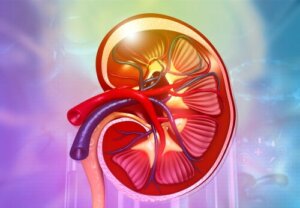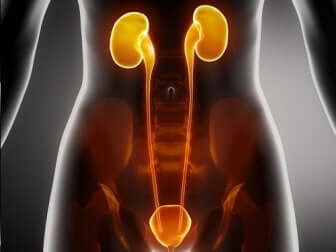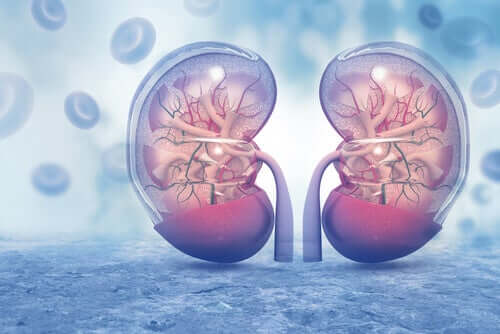What Do Your Kidneys Do?


Written and verified by the doctor Leonardo Biolatto
The kidney is a complex organ that’s responsible for eliminating waste substances from your body through urine. Normally, people have two kidneys, which are located in the back of the abdomen, next to the spine, and under the ribs.
The kidneys have a bean shape. They’re essential organs as life isn’t possible without them functioning correctly. However, thanks to technological advances, there are techniques such as dialysis or transplants that allow doctors to replace them.
In addition to urine production, the kidneys participate in many other processes, such as regulating blood pressure. Therefore, in this article, we’ll explain what kidneys do, their anatomy, and their main characteristics.
Kidney anatomy
The kidneys, as we mentioned, are bean-shaped, with one side concave and the other convex. The renal artery enters the concave part, which carries the blood with the waste products from the body that go to the kidney. The renal vein and ureter also exit from that part.
The kidney has two main parts: the cortex and the medulla. The cortex is the outermost part and the one that receives the most blood flow. It’s mainly responsible for filtration and reabsorption. In addition, it contains almost all the glomeruli, which we’ll explain later.
The medulla is made up of a series of structures that are responsible for conducting the urine the kidney produces to the ureter. The ureter is a tube that runs down to the bladder, which stores urine that it will then eliminate.

Their structure is very complex, but the basic idea is that they’re made up of a series of cellular structures and membranes that allow blood to pass and filter. In addition, they’re responsible for secreting certain substances and reabsorbing others, such as potassium.
You might like: Improve Kidney Function with These Foods
What do the kidneys do?
We already mentioned that the main function of the kidneys is to eliminate substances through urine, but this isn’t its only function. This organ also plays a very important role in the secretion of certain hormones and substances.
First of all, we have to highlight that the kidney allows vitamin D to be transformed into its active form. This vitamin is essential for metabolizing calcium. In addition, the kidney produces erythropoietin, which is responsible for stimulating the synthesis of red blood cells in your body.
On the other hand, the kidneys are essential for certain processes that allow homeostasis in your body. In other words, they help your body to maintain an internal balance even if the conditions in your environment change.
For example, they regulate both blood pressure and the pH levels of your blood. They also control plasma volume, since they modify the concentration of urine and can prevent water loss in dehydration situations.

You might be interested in: How COVID-19 Affects the Kidneys
How do they filter the blood?
Blood reaches the nephrons through the renal artery, where this artery branches into smaller ones that form the glomerulus. The glomerulus allows small molecules, fluids, and toxins to pass into the tubules. This way, they retain the largest elements, such as cells.
In addition, the glomerulus consists of a series of tubes in which the body reabsorbs much of the filtered water or certain substances that it needs. For example, it can reabsorb sodium or potassium molecules.
Conclusion
What you should remember is that the kidneys are complex organs that, in addition to producing urine, are responsible for many other functions. These include the synthesis of erythropoietin and controlling blood pressure.
All cited sources were thoroughly reviewed by our team to ensure their quality, reliability, currency, and validity. The bibliography of this article was considered reliable and of academic or scientific accuracy.
- The Kidney & Urology Foundation of America. (n.d.). Retrieved April 21, 2020, from http://www.kidneyurology.org/Library/Spanish/Los_rinones_y_su_funcionamiento.php
- ¿Cuál es la función principal de los riñones y cómo funcionan? – Zona Hospitalaria. (n.d.). Retrieved April 21, 2020, from https://zonahospitalaria.com/cual-es-la-funcion-principal-de-los-rinones-y-como-funcionan/
- Los riñones y su funcionamiento | NIDDK. (n.d.). Retrieved April 21, 2020, from https://www.niddk.nih.gov/health-information/informacion-de-la-salud/enfermedades-rinones/rinones-funcionamiento
This text is provided for informational purposes only and does not replace consultation with a professional. If in doubt, consult your specialist.








